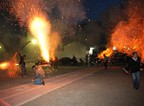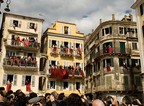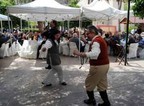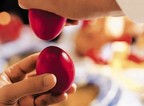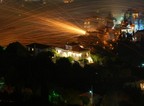In every corner of Greece, the Greek Easter is celebrated in a unique way. Customs and traditions come to life and folklore events take place in the biggest celebration in Christendom. The paint and crack of the eggs, the Procession of the Epitaph on the streets and the transfer of the Holy Light from the church at home are the most common customs. Each region, however, has its own way of celebrating both the Passion and Resurrection.
-Pottery is thrown from the balconies in Corfu on Holy Saturday
-The rocket war still exists in Chios
-The custom of Kalamata saitopolemos stems from the liberation struggles of 1821
-The balloons are raised and lit the sky of Leonidio
-The representation of the Crucifixion in Paros
-Young people actively involved in the custom of “Cradle” in Kythnos
- Central Greece
In Delphi, the day of Greek Easter begins the procession of the Icon of St. George which is accompanied by about 500 people, all dressed in traditional costumes. On Sunday the festival of St. George begins, which lasts until Wednesday and includes dances, songs and games, such as shot put, wrestling and stone lifting.
At Nafpaktos, on the evening of Good Friday, crowds of people, locals and visitors, followed by the procession of the Epitaph, form processions which pass through the port. There are lighted torches, special caps placed on the castle. In the middle of the harbor entrance the torches form a large cross, which lights up the harbor forming a spectacular picture. The custom combines a religious ritual with the memory of the heroic efforts of captain Anemogiannis to set fire to the Turkish flagship in this area.
At Leonidio the evening of the Resurrection the sky is filled with bright balloons, which are lifted by the pilgrims of each parish. The balloons were constructed in the village in the late 19th century and the residents of Leonidi continue to make them until today. The custom has its roots in local sailors travelling around the world were impressed by a corresponding custom at an Asian country and then carried it home. “Five hundred balloons are made about every Easter in the village of the five parishes.
In Kalamata, people are reviving a custom that stems from the liberation struggles of 1821, there is the contest of “mobs” (groups of players) or otherwise saitopolemos. According to legend, the Messenians used shuttles filled with explosives and intercepted the Turkish cavalry, startling the horses and proving once again that winning a battle is not acquired only via numerical superiority. Contestants in traditional costumes and armed with shuttles, cardboard tubes filled with gunpowder, engage in saitopolemos .
The Syrian Catholics and Orthodox celebrate Easter at the same time. The Epitaphs of Catholics in Ano Syros start at the Cathedral of Saint George. In Ermoupoli the Catholic epitaph begins at the evangelical church, while the epitaphs of the Orthodox start from the parishes of St. Nicholas, and the Assumption Cathedral of the Transfiguration.
During the procession they meet at the central square Miaoulis.
In Paros, the procession of the Epitaph of Marpissa makes fifteen stops. At each stop an area of the mountain gets lighted and children dressed as Roman soldiers or Disciples of Christ depict scenes from the entrance to Jerusalem, the prayer on the Mount of Olives, the Martyrdom of the Crucifixion and Resurrection. When the epitaph finishes, candles do not get thrown away but when there is a storm they are lighted to make it go away.
On the island of the Apocalypse, Patmos, at the focus of ceremonies and services is the “basin”. It is adorned with palm and brilliant variety of spring flowers. On Thursday the reconstruction of the “Last Supper” takes place at the central square of Chora, where the abbot washes the feet of 12 monks, as did Jesus with his disciples. On Easter Sunday, at the Monastery of Patmos the second resurrection is celebrated when we can hear the Gospel read in seven languages (Italian, Russian, French, English, German, Serbian and ancient Homeric Greek).
In Chios, the most famous rocket war is an old custom that has its roots in the Turkish occupation. Since the makeshift cannons made by the parishioners we have reached at today’s homemade rockets, fireworks made from nitrogen, sulfur and gunpowder. The preparation of the rockets starts immediately after the Easter In order for the fireworks to be ready for the next year. The quantities in recent years have reached a few thousand and the spectacle created by rockets fired into the sky is really impressive.
Pottery is thrown from the balconies in Corfu on Holy Saturday. At 11 am on the morning of Holy Saturday when the service of the first Resurrection is finished as well as the procession of the epitaph of St. Spyridon, the bells of the churches start to ring and from the windows of the houses clay pots filled with water (botides ) are dropped by thousands, onto roads. This custom has its roots in the Gospel text “Thou Lord resurrected and crushed them as a potter’s ware.”
In most villages of Crete, before the resurrection, all the children gather wood, and anything else that can be burned and leave it at the courtyards of churches. On the eve of Easter a pile of woods is formed and on top of it they lace Judah, a scarecrow made from an old suit and while the priest says “Christ has Risen” they light the fire and burn it. The night becomes a day by the so many fireworks and the bells of the villages ring.
